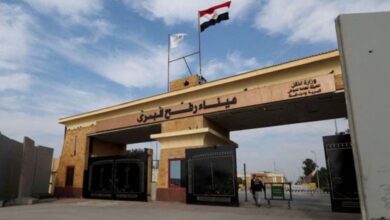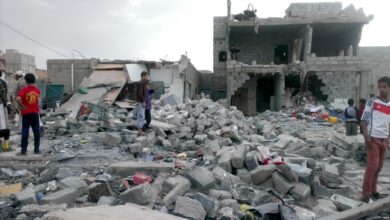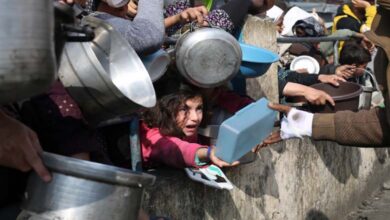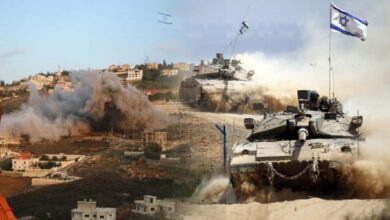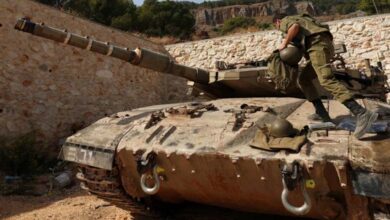October 7 Attack: How It Happened
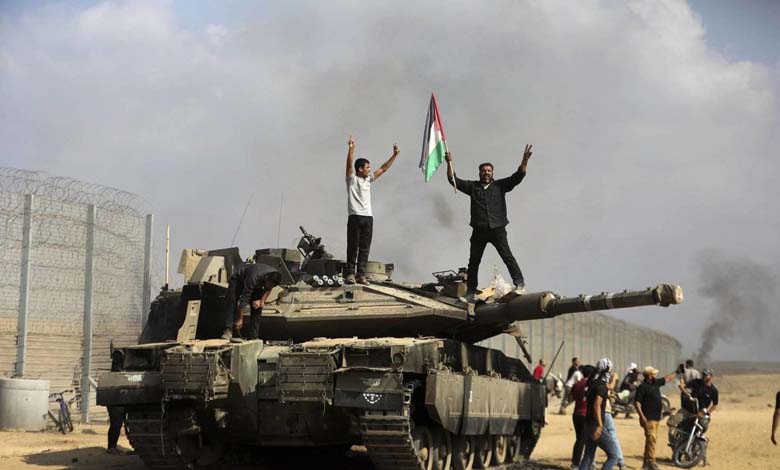
At dawn on Saturday, October 7, 2023, the eyes and ears of Israeli defense were sleeping, while sleep was fleeing from its southern part.
-
One Year After October 7: What Has Changed in Israel?
-
How did Hezbollah betray Hamas after its involvement in the October 7th attack?
It was 6:30 a.m. when Hamas militants breached a 40-mile (64 km) barrier with Israel, a barrier once dubbed a “iron wall,” connected to a labyrinth of rooms filled with cameras and high-tech scanning devices.
A Dramatic Scene
That morning seemed to be a dramatic scene, showing heavily armed militants with a variety of light and heavy weapons, while others flew over the wall and entered the Israeli towns located in the Gaza Strip, using motorized paragliders, some on motorcycles, trucks, bulldozers, and also boats at sea, overflown by drones.
-
Was America aware of the October 7th attack? What’s the story behind the ‘Jericho Wall’ document?
-
Palestinian released prisoners: This is what happened to detainees in Israeli prisons after October 7th
In the light of that foggy morning, inaudible under the roar of the first salvo of 2,200 rockets fired on southern and central Israel, Hamas fighters used cutting tools to pierce holes in a double fence 20 feet (6 meters) high.
Footage aired at the time on social media was captured by security cameras, dashboard cameras from cars, as well as by the phones of militants and victims.
-
Israel deploys falcons after October 7 attack… How and why?
-
The October 1 Paradox: Israel returns to southern Lebanon after 18 years of withdrawal
As its men crossed the border, Mohammed Deif, the Hamas military chief—who, earlier this year, had been reported dead by Israel—heard his voice message: “It’s time for Israel to act without accountability. We thus announce the deluge of Al-Aqsa.” According to Israeli estimates, about 1,500 militants breached the border under a sky illuminated by rocket fire.
A surprise attack on a country with one of the most advanced intelligence systems in the world caused, according to the Israeli army, the deaths of around 1,200 people, including 247 soldiers.
Israel claimed to have killed about 1,500 Hamas militants on its territory that day.
Materials and Elements
According to a BBC analysis, five armed Palestinian groups joined Hamas in the deadly attack on Israel on October 7 after jointly training military exercises since 2020.
The groups conducted joint exercises in Gaza, closely resembling the tactics used during the deadly attack, including in a site located less than a kilometer (0.6 miles) from the barrier with Israel, and shared this on social media.
During these exercises, the last of which took place 25 days before the attack, militants practiced hostage-taking, raids, and breaching Israeli defenses.
-
Israel Attacks Central Beirut for the First Time
-
Gaza Setback and the Success of Israeli Spies: An Analysis of Hezbollah Infiltration
In one of the most remarkable elements of their preparations, Hamas built a fictitious Israeli settlement in Gaza during one of the exercises, where the elements practiced military landings and incursions. As stated by a source close to Hamas to Reuters.
Regarding this point, the source said, “It is certain that Israel saw these (exercises), but they were convinced that Hamas was not eager to enter into confrontation.”
-
Israel Considers Ceasefire with Hezbollah While Continuing Escalation
-
By the numbers… A year of destruction in Gaza
An Attack in Four Parts
According to the source, “Hamas leaders were unaware of the plans, and while they were training, the 1,000 militants deployed in the attack had no idea of the precise objective of the exercises.”
And when the day came, the source continued, “the operation was divided into four parts.”
The First Part: A salvo of 3,000 rockets fired from Gaza coincided with incursions by militants flying using suspended paragliders or motorized paragliders across the border.
Israel had previously announced that 2,500 rockets had been initially fired.
-
“The Island”… What do we know about Israel’s latest plans for northern Gaza?
-
After new demands from Hamas and Israel’s intransigence… have the Gaza truce negotiations stalled?
After the Hamas elements landed on the ground with the paragliders, they secured the area to allow the “Elite Commandos” unit to breach the electronic and reinforced concrete wall that Israel had built with billions of dollars to prevent infiltrations.
The militants used explosives to pierce the barriers, then quickly started with motorcycles, engaging in combat with Israeli forces in the watchtowers fixed along the wall.
Meanwhile, bulldozers widened the breaches, allowing more militants to enter aboard all-terrain vehicles, as well as larger vehicles, scenes that were shared on social media.
-
Gaza Negotiations: 7 Arduous Hours
-
Gaza War: How Did “Amazon” Contribute to the Precision of Israeli Airstrikes?
After the breach, large groups of Hamas fighters quickly headed toward several military bases on the far side of the border, apparently aware of their location and planning, as well as the best approaches to avoid detection.
In the first minutes of the attack, snipers “shot at the watch points” scattered along the barrier, an Israeli army spokesperson told AFP.
The planning reached the final stage, according to a Reuters source, which consisted of transferring hostages to Gaza, which was primarily achieved at the beginning of the attack, with Hamas and other factions capturing people fleeing a party near Kibbutz Re’im, along with dozens of soldiers.
-
In Gaza: Bombing and Overcrowding, Two Faces of One Death
-
Hostage Operations: How Does Israel Gather Intelligence in Gaza?
Images on social media showed dozens of people running through fields and on the road as gunfire was heard.
In a revealed quote from an interrogation of a Hamas member who participated in the attack, he stated: “It took five hours before they shot at us. We were ready with 1,000 fighters and breached the fence at 15 points,” as reported by The Guardian from Israeli Channel 13.
Israeli soldiers shared accounts in posts on social media and during media interviews, all referencing an initial collective attack to neutralize the surveillance and communication systems in the barrier.
-
Despair Increases in the “Death Zone”: UN Alarm Over “Appalling Conditions” in Gaza
-
Israel Announces End of Military Operations in Gaza
The Concealment
Describing the plans of the most astonishing attack since the October War nearly half a century ago, a source close to Hamas told Reuters: “The movement gave Israel the impression that it was not ready to fight.”
He explained that Hamas “used unprecedented intelligence tactics to deceive Israel over the past few months, giving a general impression that it was not ready to enter a fight or confrontation while preparing for this massive operation.”
-
Gaza Negotiations and Hostage Families: Mounting Pressure Awaiting the ‘Last Chance’
-
From Underground… How Does Yahya Sinwar Communicate with Hamas Leaders Inside and Outside Gaza?
At the same time, Hamas sought to convince Israel that it cared more about ensuring that workers from the Gaza Strip—a narrow strip of land populated by over two million residents—had jobs on the other side of the border, and that it had no interest in triggering a new war.
Since the 2021 war with Hamas, Tel Aviv has sought to offer a level of basic economic stability to Gaza by proposing incentives, including thousands of permits allowing Gaza residents to work in Israel or the West Bank, where wages in construction, agriculture, or services can be ten times higher than in Gaza.
-
Analysts reveal the suffering of citizens in Gaza due to the ongoing conflict
-
Illusory Optimism or New Pressures: What Lies Behind American Claims About Ceasefire Negotiations in Gaza?
An Israeli security source acknowledged that Hamas had deceived its security services. She stated: “They made us believe they wanted money, but they were engaged in exercises all this time until it became uncontrollable.”
As it emerged in the days following the attack, Hamas had spent months, if not years, gathering intelligence on Israeli operations along the border, according to the British newspaper The Guardian.
-
Three Arab States Refuse to Participate in Gaza Peacekeeping Force
-
Death Toll Rises in Gaza and Tunnel Discovered Under Philadelphi Corridor
The Guardian reported that Hamas identified weak points in the fence, including gates along the border and Israeli patrol patterns. It seems they knew where areas were effectively monitored and where they were not.
Although details are scarce regarding what Israeli security forces concluded about the planning of the attack, some sources speculated that Hamas‘s operational security might have been so reinforced that some members of its political leadership were distanced from events, as mentioned by the source close to the movement to Reuters.
-
Confessions of an Israeli Soldier: We Destroyed Homes in Gaza for “Trivial Reasons”
-
“Theft, Arson, and No Justification”.. Israeli Soldiers Refuse to Return to Gaza
Intelligence Failure
Earlier that Saturday, Israeli intelligence had captured an increase in communication activity over networks in Gaza.
According to the newspaper Haaretz, two telephone consultations took place between the southern Israeli security services, military intelligence, and police forces, but it seems there was no security alert, with the perception that everything was fine.
By the time the siren sounded in Gaza and in adjacent Israeli settlements, Israeli security forces had already let several warnings pass that had also arrived.
-
New Study Reveals Shocking Facts About Gaza War Victims in Its Early Days
-
Spokeswoman for the Palestinian Red Crescent: The Israeli Occupation Targets Hospitals in Gaza
A Clear Explanation
Hamas Secretary-General Ismail Haniyeh held an emergency meeting with the movement’s military council just before October 7 to decide on the operation’s date, with work intensifying in the weeks leading up to it.
Hamas promised its audience to “push people toward resistance” and announced incentives for young people in the Gaza Strip to join the struggle, leading to a rise in enthusiasm in the streets.
Fighting continues in Gaza, with Israeli tanks firing salvos as they carry out ground offensives.
-
CNN: New Israeli Evacuation Orders for Thousands of Palestinians in Gaza
-
Hamas is rebuilding its forces in Gaza by recruiting thousands of new fighters
A series of attacks by Israeli defense groups has resulted in increased security measures around military bases and the deployment of reservists. Israeli military officials have anticipated a long operation over the coming days and weeks to attempt to dismantle Hamas‘s military capabilities.




